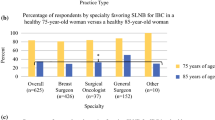Abstract
Background: Sentinel node biopsy (SNB) is an evolving technology in the management of breast cancer. The purpose of this study was to determine the success of an SNB course in emphasizing principles for participants to successfully initiate an SNB program at their institution.
Methods: Participants in a university-sponsored course were queried 6 to 18 months after the course regarding their success in initiating SNB in their practice. Univariate analysis was used to determine the likelihood of implementing a SNB program.
Results: Ninety-one participants responded. Of these respondents, 56 had initiated an SNB program at their hospital, and 20 had completed a “validation” phase. “Validation” consisted of less than 10 cases for 11 respondents, 11 to 20 cases for 5 respondents, and 20 to 30 cases for 3 respondents and >30 cases for 1 respondent. Twenty-eight percent initiated the learning curve without an Institutional Review Board (IRB) protocol, and a further 20% went on to utilize SNB without axillary dissection in sentinel node-negative patients without IRB approval. Univariate analysis revealed that surgeons practicing in a group whose caseload consisted of more than 25% breast surgery cases were most likely (P < 0.05) to implement SNB in their practice.
Conclusions: Success in applying SNB after a course is high among surgeons in groups with a significant breast caseload, although recommendations for obtaining institutional approval and completing a 30-case validation series are often disregarded.
Similar content being viewed by others
REFERENCES
Krag DN, Weaver DL, Alex JC, et al. Surgical resection and radiolocalization of the sentinel lymph node in breast cancer using a Gamma probe. Surg Oncol 1993; 2: 335–9.
Krag D, Weaver D, Ashikaja T, et al. The sentinel node in breast cancer; a multicenter validation study. N Engl J Med 1998; 339: 941–6.
Giuliano AE, Kirgan DM, Guenther JM, et al. Lymphatic mapping and sentinel lymphadenectomy for breast cancer. Ann Surg 1994; 220: 391–401.
Albertini JJ, Lyman GH, Cox C, et al. Lymphatic mapping and sentinel node biopsy in the patient with breast cancer. JAMA 1996; 276: 1818–22.
O’Hea BJ, Hill A, El-Shirbiny AM, et al. Sentinel lymph node biopsy in breast cancer: initial experience at Memorial Sloan-Kettering Cancer Center. J Am Coll Surg 1998; 186: 423–7.
Cox CE, Pendas S, Cox JM, et al. Guidelines for sentinel node biopsy and lymphatic mapping of patients with breast cancer. Ann Surg 1998; 227: 645–53.
Cody HS, Hill A, Tran KN, et al. Credentialing for breast lymphatic mapping: how many cases are enough? Ann Surg 1999; 229: 723–8.
Edwards M, Giuliano A, Reintgen D, Tafra L. American Society of Breast Surgeons Concensus Statement onthe Guidelines for Performance of Sentinel Lymph Node Biopsy for Breast Cancer. ASBS Press Release, November 2, 1998, Laurel, MD.
Guenther JM, Krishnamoorthy M, Tan LR. Sentinel lymphadenectomy for breast cancer in a community managed care setting. Cancer J Sci Am 1997; 3: 336–40.
Burak WE, Walker MJ, Yee LD, et al. Routine preoperative lymphoscintigraphy is not necessary prior to sentinel node biopsy for breast cancer. Am J Surg 1999; 177: 445–9.
Roses DF, Brooks AD, Harris MN, et al. Complications of level I and II axillary dissection in the treatment of carcinoma of the breast. Ann Surg 1999; 230: 194–201.
Hack TF, Cohen L, Katz J. Physical and psychological morbidity after axillary lymph node dissection for breast cancer. J Clin Onc 1999; 17: 143–9.
Krag DN, Weaver D, Ashikaga T, et al. The sentinel node in breast cancer-a multicenter validation study. N Engl J Med 1998; 339: 941–6.
Author information
Authors and Affiliations
Corresponding author
Additional information
Presented atthe 53rd Annual Meeting of the Society of Surgical Oncology, New Orleans, Louisiana, March 16-19, 2000.
Rights and permissions
About this article
Cite this article
Zervos, E.E., Saha, S., Hoshaw-Woodard, S. et al. Localizing the Sentinel Node Outside of the Specialty Center: Success of a Lymphatic Mapping Course in Disseminating New Technology. Ann Surg Oncol 8, 7–12 (2001). https://doi.org/10.1007/s10434-001-0007-7
Received:
Accepted:
Issue Date:
DOI: https://doi.org/10.1007/s10434-001-0007-7




